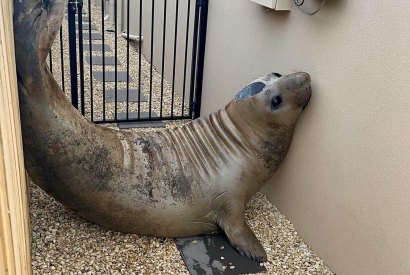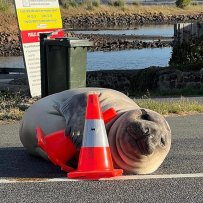
“That’s come with the inevitable animal welfare risks and safety risks, and in some situations the authorities have had to euthanise those animals to mitigate those risks. That’s absolutely the last thing we want to happen here.”
Neil was born on the Tasman Peninsula in October 2020, a long way from the closest breeding colony of southern elephant seals on Macquarie Island in the sub-Antarctic.

Neil pictured during his last visit to Tasmania in December.Credit: Instagram/@neiltheseal22
Elephant seals are known to return to the place they were born and weaned every six months to moult fur and to rest, after spending months foraging in the Southern Ocean.
Carlyon said Neil’s mother might have gotten lost when she birthed her pup on the Tasman Peninsula, to which Neil is now “programmed” to regularly return.
Without the socialisation of other seals, Neil had been known to seek out moving objects for interaction, including people, dogs and cars.
Loading
“At the moment, he’s the only one, so he’s a lonely little seal,” Carlyon said.
As Tasmania’s only resident southern elephant seal, Neil has grown into a local celebrity, with Instagram and TikTok accounts dedicated to charting his appearances at local homes, disdain for traffic cones and penchant for sleeping on roads.
But this week, the Department of Natural Resources and Environment Tasmania urged people not to tag Neil’s location on social media.
Not only is Neil’s size posing an increasing danger to the public, but he’s also needing protection from people and their dogs.

Neil the Seal has a thing for traffic cones.Credit: Instagram/@neiltheseal22
“We’re very aware he’s become a celebrity both here in Tasmania and around the world, but that comes with its own issues to manage, and our own responsibilities to help keep him safe,” Carlyon said.
“The risks to Neil from increased attention from people are quite considerable.”
Last year, Neil turned up at Kingston Beach, south of Hobart. “It got to a point where we actually had to sedate Neil and move him away from all that attention, there were just hundreds of people visiting him [and] disturbing him,” Carlyon said.
“He wasn’t allowed to rest and there were people approaching far too closely, and that comes with its own human safety risks.”
Southern elephant seals have a unique physiology that could make sedation risky, Carlyon said.
“Sedation itself and moving Neil is a big operation that comes with significant risks, and we really risk doing harm to Neil in that process … so that’s a last-resort option.”
Get to the heart of what’s happening with climate change and the environment. Sign up for our fortnightly Environment newsletter.









 Add Category
Add Category